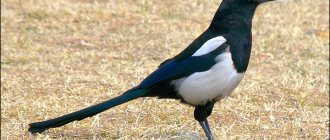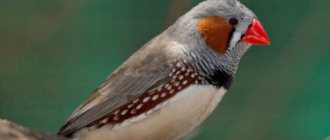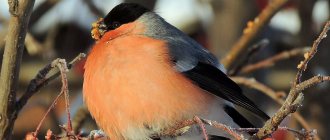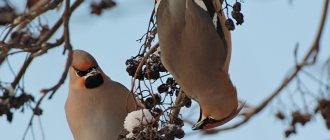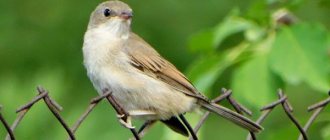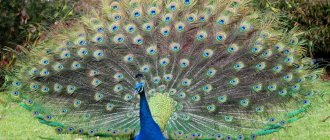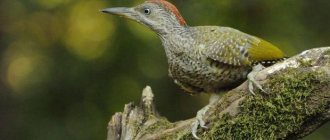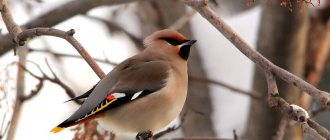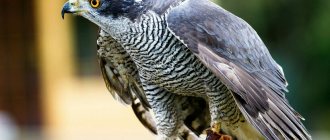- Wild animals
- >>
- Birds
The sparrow is a bird that every person has met.
This small bird has become an indispensable attribute of the trees growing in the yard, a herald of approaching warm days and impending rainy weather. Where the feeders hang, the ringing hubbub of sparrows is constantly heard, and with the approach of spring, their cheerful chirping can be heard everywhere. Little sparrows have become heroes of fairy tales, stories, sayings, nursery rhymes, proverbs and even folk superstitions. Let's take a closer look at the life activity of this small, but nimble and very famous bird.
Appearance and description
The sparrow is a small bird whose colors include grey, brown and black. The belly and head are light in color. Moreover, the color in these places varies from gray to brown, and small black areas may be present. The wings and tail are always dark in color. Depending on the species, the back of the bird's head is painted a certain color, and there may be white stripes on the wings.
Appearance of a sparrow
Appearance of a sparrow
Appearance of a sparrow
Appearance of a sparrow
Appearance of a sparrow
The body of the sparrow is oval in shape, the neck is short and thick, which makes it seem as if it is almost completely absent. The bird presses its wings tightly to its sides and moves them slightly back.
The beak is black in most cases, the tail is short. The eyes are small and bead-shaped. Inside there is a black pupil, and around it there is a gray-brown border. The bird's paws are small, with small claws on the toes.
Why can’t you feed birds salted lard and fried seeds?
Any disease that affects a bird in the winter becomes many times more dangerous for it than it would be in the summer. Gastrointestinal diseases in birds are quite common, as during harsh winters they may eat junk food in search of survival. This food is offered to them by a person who knows little about the feeding habits of animals.
INTERESTING: It turns out that chewing gum thrown away by humans is often perceived by birds as a piece of bread. They peck at it, but then die, since the chewing gum completely inhibits and clogs their digestive tract.
When offering lard to tits and other birds, make sure that you do not cut it from the salty part. Salt is poison for birds. Their kidneys and liver cannot digest and remove it, and therefore such a product will be certain death for the small creature.
It would seem that sunflower seeds are the healthiest food for birds. But only if the seeds are raw. Roasted seeds absorb too much fat and the birds’ gastrointestinal tract cannot absorb it, causing poisoning, diarrhea and indigestion, which is very destructive for most species.
Features of harmful food for birds in winter
Dimensions
Adults usually grow up to 14 cm, but some, especially large ones, stretch up to 18 cm. The weight of the bird is approximately 35 grams, and the wingspan is 27-30 cm. Males usually grow larger than females, which makes it possible to distinguish them from each other. Such small sizes help sparrows remain invisible in the foliage of trees and hide from predators.
Interesting fact : sparrows, like magpies, tend to grab small shiny objects and take them to their nests.
Differences between a male and a female
Male and female sparrow
You can distinguish a male from a female not only by size, but also by color. Males have a black spot under the beak, shaped like a tie, and the head is brown in color, and sometimes there may be areas of a reddish tint on the cheeks. Females have a gray nape and beak. Females also have light brown feathers on their wings, which are absent in males.
What does it eat?
Sparrows often feed on nuts and grains.
Sparrows can be found almost everywhere: in cities, villages, fields and forests. Wherever a person goes, everywhere he can see flocks of these wonderful birds. The majority of sparrows live side by side with humans. They build nests near houses, and people constantly feed them.
Interesting: Interesting facts about water, photos and videos
The sparrow is a bird that is not picky about food and does not refuse the grain mixture; it picks up all the seeds and crumbs that have fallen to the ground. Sparrows also eat seeds on branches and eat weeds left over from the fall. They love to eat viburnum and rowan berries. Understanding people, when picking berries in the fall, leave some on the tree to feed the birds.
What to feed a sparrow in a feeder
A flock of sparrows gathered at a feeder photo
In winter, sparrows fly to a person's house in anticipation of being fed. People believe that sparrows can be fed with bread crumbs. But flour products are harmful to the digestive system of birds. It is recommended to feed birds with cereals and seeds. The seeds must be raw. Pieces of lard are a necessary protein for the full functioning of the bird's body.
Habitat - where it lives
Habitat of the House Sparrow
Different species of sparrows live almost all over the world. The exception is areas that are too cold or hot, where food is almost completely absent. The bird’s body copes well with any weather conditions, so its absence in a certain area in most cases is associated only with heavy food production.
Sparrows willingly settle near humans: people often leave food in special feeders, which greatly simplifies the process of finding food. The bird is also found in forests, fields, tundra and other areas.
Lifestyle
Flock of sparrows photo
Sparrows are not migratory birds. Sparrow birds lead a sedentary lifestyle and rarely leave their permanent place of residence. The offspring, having matured, remain with their parents until the end of their days. Birds form large flocks of hundreds of individuals.
Sparrows are by nature pugnacious, harmful creatures. Defending territory, they attack unwanted birds and animals in whole flocks. Even larger birds prefer not to mess with the impudent little ones. Sparrows are not averse to fighting with their relatives. They often fight over a female or a vacant nest. Calm, peaceful coexistence is unknown to them.
Sparrows sitting on a branch
Any event is accompanied by commotion, noisy sounds and, of course, a fight. In winter, sparrows behave calmer. In cold weather they sit in dense flocks on wires or bare branches of trees and sit with their heads ruffled, occasionally talking to each other. In summer, the sparrows cannot be appeased. From dawn to the last ray of the sun they chirp, rummage through garbage cans in search of food.
The average lifespan of sparrows is 4-5 years. Most birds die in the first year of life due to bad weather conditions and injuries (sparrow chicks often fall out of the nest).
Features of behavior
Photo of a red sparrow sitting on a rope photo
Sparrows are sociable, friendly birds. They live in close proximity to animals, other birds and humans.
True, noisy and fussy by nature, they do not always get along with swifts and tits. The latter often leave the territory where the family of sparrows is located - they cannot stand the impudent behavior of small mischief-makers.
It is known that sparrows have developed memory. It has been proven that they can form a logical chain of events. They are afraid of cats, but love to tease them by jumping on their short legs near her bowl. Sparrows feel right at home in the barnyard. They feed from the same feeder with chickens and ducks.
sparrow nest
Sparrow's nest
Sparrows settle in residential buildings, building nests under eaves and on common balconies. Birds can also live in tree hollows. Sparrows do not like to spend a lot of time creating a nest, so they often simply pile pieces of grass, straw and leaves in a secluded place. Due to the fact that the structure is fragile, it can be destroyed by winds and heavy rains. In this case, construction begins again. The diameter of the nest is approximately 12 cm, the height is 7 cm. The bottom is lined with feathers, leaves and materials that can provide heat. The outlet of the nest is located on the side.
Interesting fact : sparrows are able to occupy other people's nests, evicting the previous inhabitants.
Character and lifestyle
Sparrows prefer to stay in one territory for a long time and rarely fly to other places. If there is enough food on the lands chosen for habitat, the birds immediately build nests and settle in them.
Sparrows gather in flocks, and the offspring do not leave their parents. If there is enough food in the area, the birds become quite prolific, causing their numbers to grow rapidly. Sparrows form pairs for life.
When interacting with other males that are part of the pack, males are capable of showing aggression. Then they begin to chirp loudly, spread their wings in different directions and jostle with their opponent.
How do sparrows reproduce?
Beginning in April, female sparrows lay eggs in a specially built nest. In one season, a female individual can do this about five times. Each clutch contains up to 7 eggs. These small-sized birds are quite fertile. The appearance of sparrow eggs is very interesting; they are white in color and have a lot of small black inclusions. This coloring helps make them less noticeable to those who want to feast on the internal contents.
Hatching begins immediately after laying and can last up to two weeks. Not everyone will like the appearance of newborn chicks; they have very little fluff and a rather strange appearance. Therefore, in the first days, the parents of the sparrows watch them especially carefully and warm them with their warmth. At the same time, mom and dad feed them; this period often lasts from two weeks to seventeen days. The preferred food for chicks during this period is ordinary insects. They provide many useful substances that help the little sparrow grow and develop well. It is quite interesting that both parents are involved in feeding, without dumping the important work on one.
Starting from the tenth day of life, babies begin to try themselves in flight and actively learn this craft. This takes them extremely little time, and after just a couple of days they are ready to leave the parental nest. This occurs at the end of May or beginning of June. Already in the fall, the little sparrows become fully grown, and by this time they are looking for a mate. During this period, they are very loud, because they want to find a worthy female with whom they will build a winter nest and spend the cold times in it. During this period, egg laying and incubation do not occur; young sparrows wait until spring to give birth to new offspring. And a nest built in the fall serves perfectly as shelter from rain, wind, and snow. During this period, the weather is very unstable, so all the birds try to find and arrange a place for themselves as comfortable as possible. Of course, if you find a mate, this task will be completed much faster and with better quality.
Reproduction and offspring
Sparrow chick
Sparrows build nests in the cracks of buildings, they especially like to settle under the eaves of houses, also in hollows of trees and in birdhouses. There are 4-10 white eggs with brownish speckles in a clutch; the chicks hatch after 11-13 days. Both parents incubate the eggs in turns, and begin to do this as soon as the female lays the first egg, so the difference in age, and therefore in weight, in the chicks is up to 10 days, and this is a lot for small birds.
Because of this, in large clutches, younger chicks usually do not survive. The cubs are under the care of caring parents until they learn to fly well. Until then, the chicks are protected from predators and fed with insects. Over the summer, a married couple manages to raise 2–3 broods.
Interesting: Interesting facts about Greece
Signs about sparrows
Sparrow sitting on a support photo
Among the people, sparrows are considered harbingers of misfortunes and large-scale changes. Esotericists believe that the soul of a deceased person flies with a sparrow, trying to communicate about impending changes in people’s lives.
If a sparrow flies into the house, then the owner is in for news that will greatly surprise him. A sparrow entered a home through a window - a person will face troubles at work and at home. For example, equipment breaks down, a faucet breaks, or neighbors flood. A sparrow knocks on the window - pay more attention to pressing matters, otherwise you will fail. If a sparrow hits a window, then this sign indicates that there is a need to resolve complicated matters on which one’s career or family well-being depends.
Sparrows bathe in a puddle - what is this for? Our ancestors also explained this behavior of birds by the fact that if a sparrow splashes in the water, it means that a dry season is coming. If there is no rain, there will be no harvest. That is, the bathing of sparrows was associated with grief, hunger, and pestilence. Now this sign also has a negative connotation: if a sparrow bathes in a puddle, expect trouble.
Seeing a sparrow in a dream is a sign of impermanence and uncertainty. If you had a dream in which a sparrow died, in reality a person will face serious troubles. A sparrow in a cage means a serious illness. Hearing a sparrow tweet means encountering an obstacle on the way to your intended goal.
Natural enemies
The owl is one of the natural enemies of the sparrow.
In nature, the sparrow has many natural enemies. The main ones are yard cats, who do not deny themselves the pleasure of feasting on this prey. The sparrow can also be pursued by birds of prey. For example, owls and hawks are able to grab unwary individuals with their paws and carry them to a secluded place. Due to the large difference in size, the sparrow is physically unable to resist.
Interesting Facts
Male sparrows in a fight photo
- The sparrow's eye sees everything in pink.
- The number of cervical vertebrae in a sparrow is twice that of a giraffe.
- A baby sparrow is popularly called a “yellowthroat” (due to the yellow color of its mouth). In colloquial speech, “yellow mouth” means a young, inexperienced person, a teenager.
- There is a red sparrow in nature. However, this bird has nothing in common with real sparrows. Its other name is lentil and it belongs to the finch family. The size of the lentil is similar to the sparrow, and the color of the feather is bright red.
- The homeland of sparrows is Southeast Asia.
- The passerine population consists of 1 billion individuals.
- Sparrows can fly for no more than 15 minutes.
- The diet of young sparrows consists of 1000 different insects
- The sparrow's body temperature is 44 degrees.
- Short legs do not allow the sparrow to walk, so it jumps.
- People say “The word is not a sparrow; if it flies out, you won’t catch it.” The word is compared to a bird, that is, thoughtless words can fly out and offend a person. You should think carefully before opening your mouth.
Kinds
In nature, there are more than 30 species of sparrows that have certain characteristics and a unique appearance. Below are the main ones.
Black-breasted Sparrow
Black-breasted Sparrow
The species has a second name - “Spanish Sparrow”, and is found in Spain, Iraq, Asia, Africa and Pakistan. The bird has a brown color on its head, wings and neck. The back and area near the eyes are covered with light spots. There are a large number of black markings on the abdomen. Males are brighter in color than females. The average size of the bird is 16 cm.
Snow sparrow
Snow sparrow
Adults grow up to 18 cm, weight ranges from 30 to 58 g. Snow sparrows live in the Alps, the Caucasus, Asia and the Balkans. The bird has a white chest and tail. The wings have black and brown feathers. You can see a small tie on the neck.
Red sparrow
Rufous Sparrow
The main distinguishing feature of the species is the presence of bright orange areas on the head, back and wings. The red-haired sparrow is found in Asia, India, and Sakhalin. The wingspan of an adult is approximately 8 cm. Birds often gather in flocks of 15-20 individuals for survival.
Stone sparrow
Stone Sparrow
The beak of stone sparrows is orange, and there is a light stripe on the head. The bird's color is white and brown, with some feathers having gray and black areas. The size of the stone sparrow ranges from 14 to 17 cm, weight does not exceed 40 g.
Mongolian ground sparrow
Mongolian Ground Sparrow
Individuals of this species have an elongated body and a gray color. There are white spots on the body, and orange and black feathers are present on the wings. The main population of the species lives in Mongolia and can also be found on the border with Russia.
Short-fingered sparrow
Short-fingered Sparrow
Most individuals are sandy in color, with feathers that have light edges and dark brown areas. The beak is dark pink, the eyes look like black beads. Individuals grow no more than 15 cm in length, and their weight is 35 g.
Why was it called "Sparrow"
It is believed that the name of the bird comes from the ancient Slavic word “gorobets”, which means “pockmarked”. Considering that the sparrow’s color has many areas where there are black and gray spots on a brown background, it could have gotten its name based on just such a feature.
Interesting: Interesting facts about Ancient Mesopotamia (Mesopotamia)
There is also an opinion that the bird was so nicknamed because of the sounds it makes. The sparrow communicates with trills similar to “vrk-vrk.” This sound is similar to the ancient word “vork”, which means “to grumble”, “to coo”.
Population and species status
In recent years, ornithologists have noticed that the sparrow population has begun to gradually decline. Previously, huge flocks of birds flew, but now you can only see a few dozen individuals, and even then not in every yard. What is this connected with?
Sparrows are disappearing due to poor quality food filled with chemicals. Sprayed chemical fertilizers are increasingly being used on fields. Birds that eat grain from farm lands stop producing calcium in their bodies, which is necessary for the construction of eggshells. Also, soil and water pollution, intensive urban development, and an increase in mobile phone towers contribute to the reduction in the number of sparrows. This negatively affects the health and genetics of the birds.
Ornithologists say that in order to save sparrows, people must feed them with quality products and build birdhouses and feeders. Also, a person should monitor the purity of nature: do not throw away garbage wherever you want, also do not burn it yourself, since burning plastic is dangerous for the environment and living organisms, if possible, do not use pesticides, and treat nature with care. Scientists also claim that sparrows can be used as a biological device that can be used to determine the cleanliness of the environment.
Nutrition
Sparrows eat everything in the literal sense of the word. They don't have any special preferences. They eat insects, grain, crumbs, human food waste. These birds are not particularly modest. They can sit and brazenly look into the mouth of a person who is eating at a table in an outdoor cafe.
If you remain motionless in this case for some time, the bird can safely climb onto the table and grab what attracted its attention. The slightest movement causes the bird to flee. Birds do not have greed for food. The whole flock flocks to the tasty morsel, after which the feast begins.
Unfamiliar food is tried with great caution. Summer time is especially good for country sparrows. In the village they simply have a huge abundance of food. Moreover, the scarecrows built by people in the garden to scare away birds are absolutely not scary for sparrows.
In addition to this food, sparrows also feed on caterpillars and other harmful insects, which in large quantities can cause irreparable harm to the national economy.
Keeping at home
Sparrow in a Cage
Sparrows are not considered domestic birds, so only a small percentage of the total population grows in cages. In most cases, if an individual lives in captivity, then the person picked it up as a chick.
Interesting fact : if a chick lies on the ground, covered with feathers and down, it should not be touched. This is how he learns to fly under the watchful supervision of his parents. If the chick is so small that it has not yet begun to grow, it means that it accidentally fell out of the nest and needs help.
House sparrows contain several individuals in spacious cages. Birds quickly get used to care and care. Rock sparrows are best suited for home cultivation. They are the least aggressive and quickly adapt to isolation.
Spreading
Area
Sparrow Population Map
is large. These nimble birds are found in Europe, Russia, and Africa. Some species were exported to America, Australia and New Zealand.
Habitats
Sparrows are classified as a synatropic species - they follow a person everywhere and everywhere. They settle in noisy cities and quiet villages, close to human habitation. Wherever they find themselves, sparrows will find shelter and find a home.
A man treats a sparrow
These birds can live in any weather conditions and easily get used to the environment created by people. By the way, sparrows live even where other birds cannot survive - for example, in the tundra and forest-tundra.
Sparrow's voice
Sparrow trills cannot be called melodic. During communication, the bird emits one-time calls, similar to whistling and chirping. House sparrows have a rougher and more sonorous voice. Stone ones make dull sounds, consisting of long trills and short intermittent signals.
The black-breasted sparrow has a loud, high-pitched voice. Representatives of the species communicate in long trills that come in continuous bursts. The snow sparrow echoes its relatives with chirping sounds, which can be either short or stretched over entire long series.

